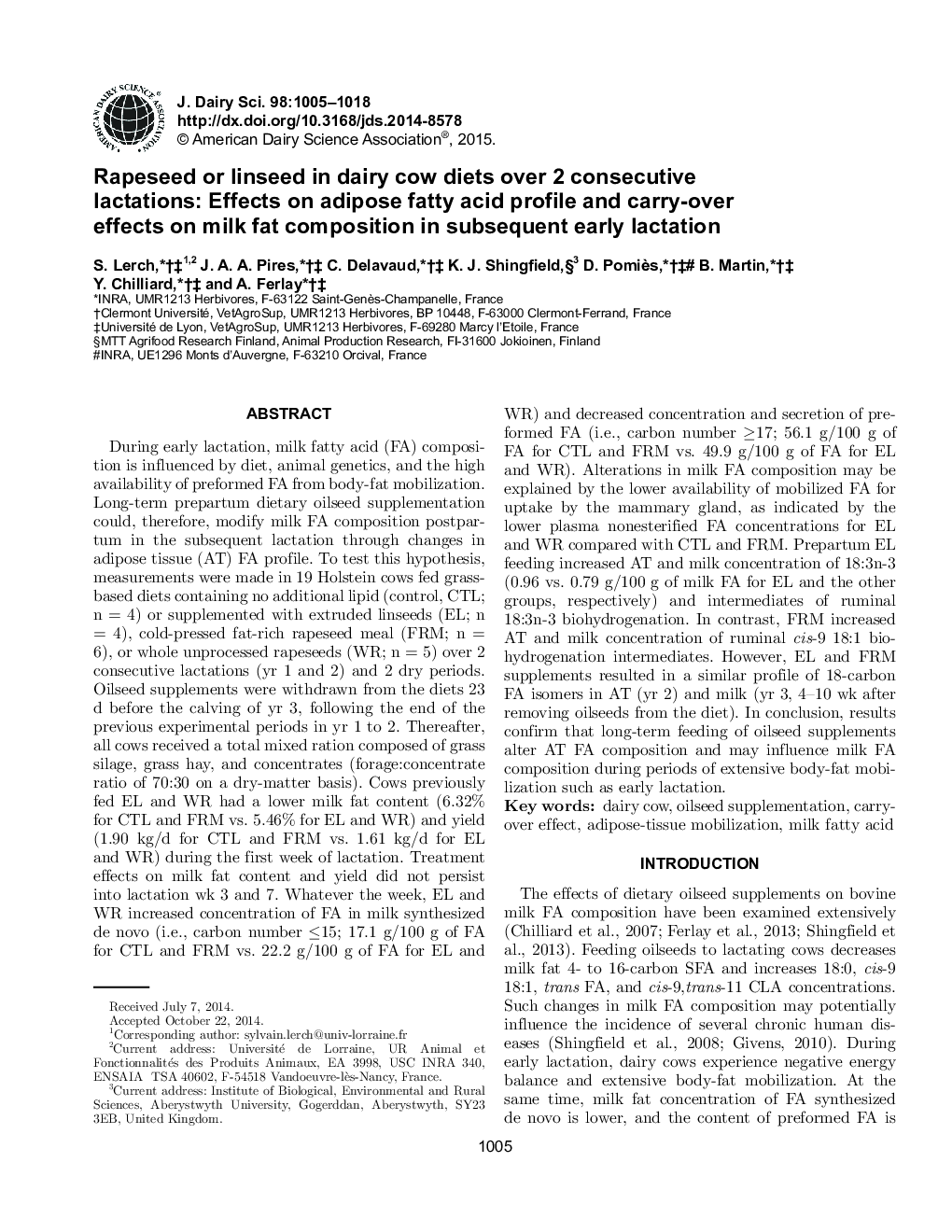| Article ID | Journal | Published Year | Pages | File Type |
|---|---|---|---|---|
| 10975404 | Journal of Dairy Science | 2015 | 14 Pages |
Abstract
During early lactation, milk fatty acid (FA) composition is influenced by diet, animal genetics, and the high availability of preformed FA from body-fat mobilization. Long-term prepartum dietary oilseed supplementation could, therefore, modify milk FA composition postpartum in the subsequent lactation through changes in adipose tissue (AT) FA profile. To test this hypothesis, measurements were made in 19 Holstein cows fed grass-based diets containing no additional lipid (control, CTL; n = 4) or supplemented with extruded linseeds (EL; n = 4), cold-pressed fat-rich rapeseed meal (FRM; n = 6), or whole unprocessed rapeseeds (WR; n = 5) over 2 consecutive lactations (yr 1 and 2) and 2 dry periods. Oilseed supplements were withdrawn from the diets 23 d before the calving of yr 3, following the end of the previous experimental periods in yr 1 to 2. Thereafter, all cows received a total mixed ration composed of grass silage, grass hay, and concentrates (forage:concentrate ratio of 70:30 on a dry-matter basis). Cows previously fed EL and WR had a lower milk fat content (6.32% for CTL and FRM vs. 5.46% for EL and WR) and yield (1.90 kg/d for CTL and FRM vs. 1.61 kg/d for EL and WR) during the first week of lactation. Treatment effects on milk fat content and yield did not persist into lactation wk 3 and 7. Whatever the week, EL and WR increased concentration of FA in milk synthesized de novo (i.e., carbon number â¤15; 17.1 g/100 g of FA for CTL and FRM vs. 22.2 g/100 g of FA for EL and WR) and decreased concentration and secretion of preformed FA (i.e., carbon number â¥17; 56.1 g/100 g of FA for CTL and FRM vs. 49.9 g/100 g of FA for EL and WR). Alterations in milk FA composition may be explained by the lower availability of mobilized FA for uptake by the mammary gland, as indicated by the lower plasma nonesterified FA concentrations for EL and WR compared with CTL and FRM. Prepartum EL feeding increased AT and milk concentration of 18:3n-3 (0.96 vs. 0.79 g/100 g of milk FA for EL and the other groups, respectively) and intermediates of ruminal 18:3n-3 biohydrogenation. In contrast, FRM increased AT and milk concentration of ruminal cis-9 18:1 biohydrogenation intermediates. However, EL and FRM supplements resulted in a similar profile of 18-carbon FA isomers in AT (yr 2) and milk (yr 3, 4-10 wk after removing oilseeds from the diet). In conclusion, results confirm that long-term feeding of oilseed supplements alter AT FA composition and may influence milk FA composition during periods of extensive body-fat mobilization such as early lactation.
Related Topics
Life Sciences
Agricultural and Biological Sciences
Animal Science and Zoology
Authors
S. Lerch, J.A.A. Pires, C. Delavaud, K.J. Shingfield, D. Pomiès, B. Martin, Y. Chilliard, A. Ferlay,
